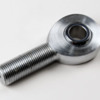quote:
....With proper rod ends, you can get BIG TIME caster because you can move the entire upper A-Arm back in the mount. I suppose you could also use rod ends on the lower A-Arm and move it forward to increase your caster as well (or a combination of the two). Just be careful when playing with caster because it's possible to get way too much caster when you start moving A-Arms backwards and forewards.
You're lucky if you can even get 2 degrees caster the average stocker. You need to move the top ball joint rearward about 3/4" on most cars to get in the 6 degree caster range. Since the spindle is located about midway between the upper and lower ball joints this means you move the wheel about 3/8" rearward with just an upper A-arm mod. This can be an issue in big tire cars that are already marginal on tire clearance.
If you move the lower A-Arm ball joint 3/8" forward (than whats possible on typical stockers) and the upper 3/8" rearward you can achieve 6 degrees caster range without biasing the spindle/wheel location rearward, at least with wheels straight, though the additional caster itself will also affect this throughout the steering range.
Many believe you can adjust caster and toe with those rubber bushing type rod ends but its only true on a very limited basis because the angular displacement causes binding in the bushings which are not designed to operate in a deflected position continuously, only intermitently. For true spherical rod ends, this is not a problem when operating within their rated range of angular deflection.
I have both a heim joint and urethane bushing suspended car. Heim joint suspension holds geometry precisely and has superior feel/feedback from smooth surfaced road. They also transmit higher shock loads from pot holes, bumps, and other typical street flaws and are much harder on mounting points because of this. So in some respects street driving can actually be tougher on them. They need to be maintained and can fail ugly if used in place of ball joints without a safety washer. Race cars also have the benefit of being frequently inspected for cracking etc. In the end it's all a matter of how the respective parts are spec'd and designed into the vehicle.
Best,
Kelly





